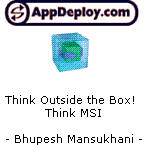Problem building package with wininstall LE 2003
We are about to migrate our Manufacturing MRP, VISUAL Mfg 6.2.8, to SQL Server from SQLBase and I am planning on redeploying the Centura Runtime 1.5 and the VISUAL Mfg shortcuts, etc.
I am using Wininstall LE 2003 to repackage the apps and deploy via group policy in the active directory.
The reason for wanting to redeploy is because I want to establish a "clean slate" with this new SQL Server install (the previous one was a shambles to say the least and is not consistent across the desktops)
I plan to have everyone's configuration files, visual.ini (and other .ini's) files kept on the users' home directory on the server, ie. Z:\visual_ini
So far I have had success with the Centura Runtime, I have it packaged and deploying sweetly to the machines. But the VISUAL Mfg part is different in that there are "user" settings held in the registry and of course the .ini files to go on the user's home directory so this needs to be installed after the user has logged on, therefore I would like to "advertise" the icon so the user can install the app when it is first launched. I have NO IDEA how to do this, and this is what I am trying to achieve....
Am I in the right department or am I just beating my head again a nail-filled wall?
cheers
Baronne [&:]
I am using Wininstall LE 2003 to repackage the apps and deploy via group policy in the active directory.
The reason for wanting to redeploy is because I want to establish a "clean slate" with this new SQL Server install (the previous one was a shambles to say the least and is not consistent across the desktops)
I plan to have everyone's configuration files, visual.ini (and other .ini's) files kept on the users' home directory on the server, ie. Z:\visual_ini
So far I have had success with the Centura Runtime, I have it packaged and deploying sweetly to the machines. But the VISUAL Mfg part is different in that there are "user" settings held in the registry and of course the .ini files to go on the user's home directory so this needs to be installed after the user has logged on, therefore I would like to "advertise" the icon so the user can install the app when it is first launched. I have NO IDEA how to do this, and this is what I am trying to achieve....
Am I in the right department or am I just beating my head again a nail-filled wall?
cheers
Baronne [&:]
0 Comments
[ + ] Show comments
Answers (5)
Please log in to answer
Posted by:
baronne
19 years ago
Posted by:
wiseapp
19 years ago
Posted by:
wiseapp
19 years ago
Hi Baronne:
It's a long way to do this task but will cut in short.
Well just do this
1. Make sure that the shortcut that you putting on the desktop or whereever should have option Advertised checked.
2. Do an administrative install of your msi on a network share by typing in this command:
msiexec.exe /a "yourmsi.msi"
choose the DFS share in the dialog where you want this to be extracted
3. Now deploy this MSI thru AD , it will advertise only the shortcut and when the user clicks on the shortcut it will install the application in case the application is not installed.
This worked under SMS not sure will work for AD but there is no harm in trying though.
Do let me know whether this helped your or not?
It's a long way to do this task but will cut in short.
Well just do this
1. Make sure that the shortcut that you putting on the desktop or whereever should have option Advertised checked.
2. Do an administrative install of your msi on a network share by typing in this command:
msiexec.exe /a "yourmsi.msi"
choose the DFS share in the dialog where you want this to be extracted
3. Now deploy this MSI thru AD , it will advertise only the shortcut and when the user clicks on the shortcut it will install the application in case the application is not installed.
This worked under SMS not sure will work for AD but there is no harm in trying though.
Do let me know whether this helped your or not?
 Rating comments in this legacy AppDeploy message board thread won't reorder them,
Rating comments in this legacy AppDeploy message board thread won't reorder them,so that the conversation will remain readable.


